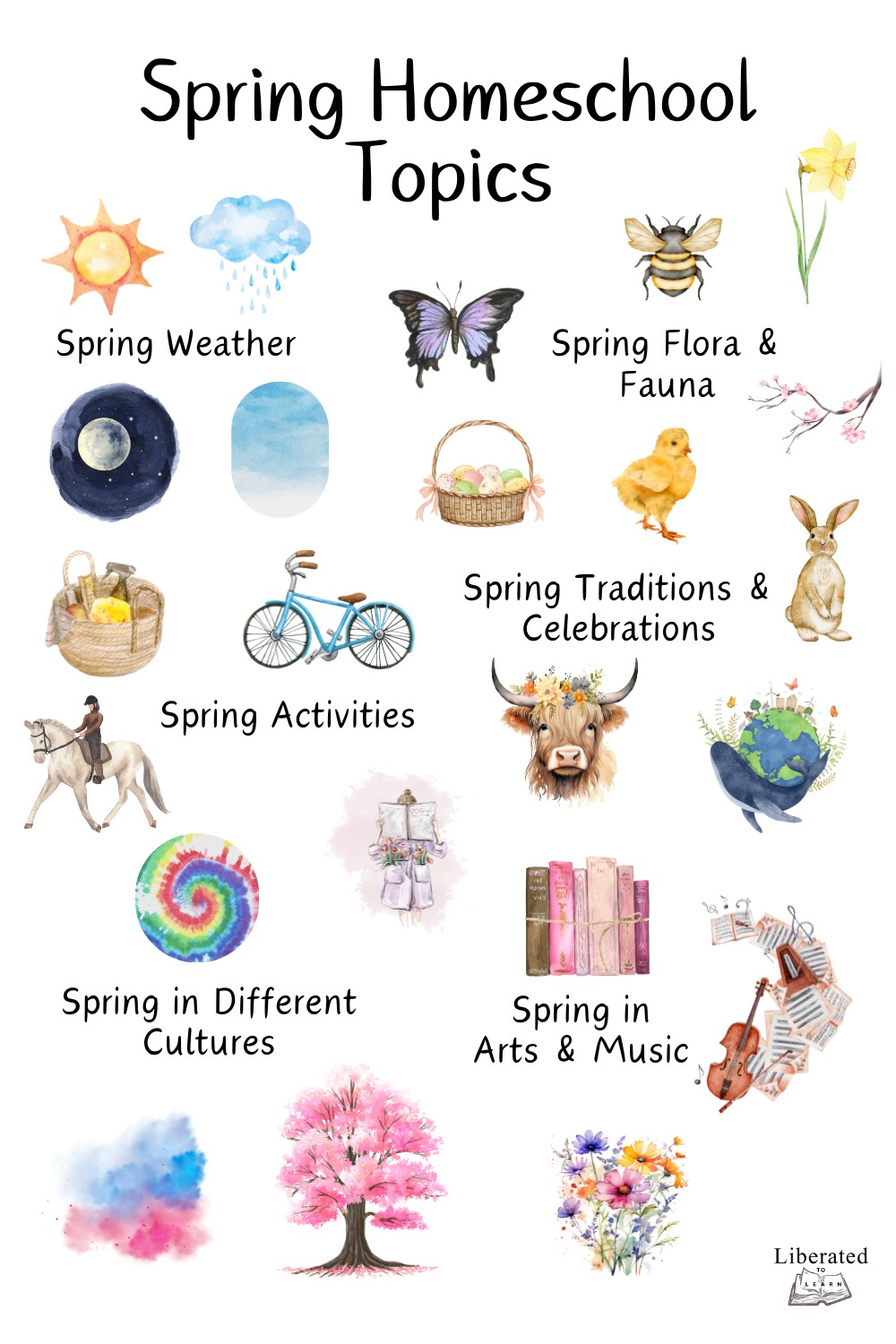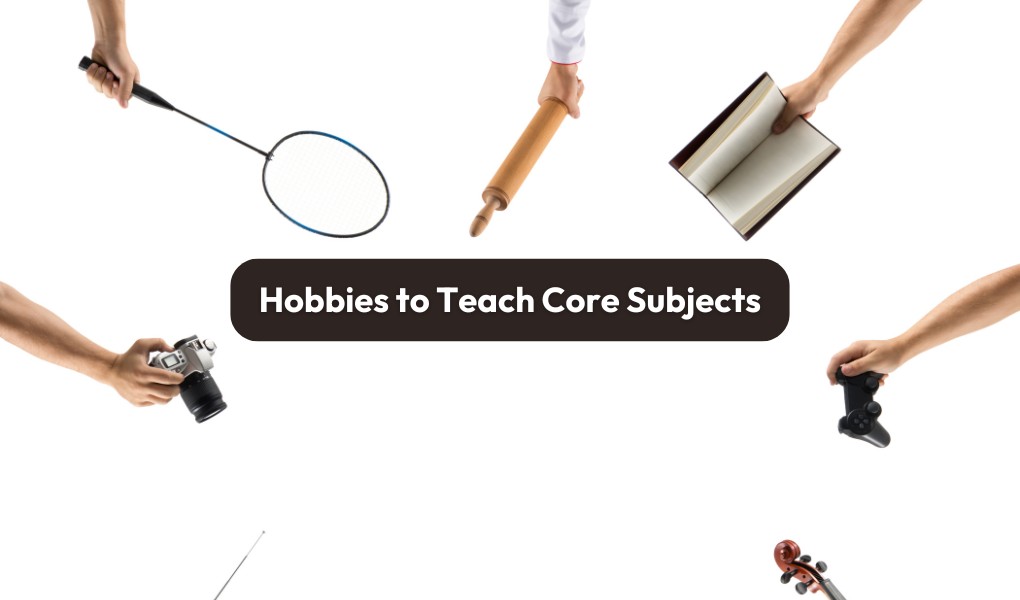We’re diving into different spring homeschool topics and creative activities that will not only help your kids embrace spring but also unleash their creativity too.

From celebrating the arrival of flowers and fresh beginnings to learning about springtime festivals across the globe, this season is brimming with inspiration. In this post, we’re diving into different spring homeschool topics and creative activities that will not only help your kids embrace spring but also unleash their creativity too.
Spring Weather
1. The Spring Equinox
The Spring Equinox signifies the start of spring. It marks the moment when the Earth’s axis is not tilted towards or away from the Sun, making day and night nearly equal.
This is a great spring topic because you can learn all about the Earth’s tilt, orbit, and how it affects the seasons.
Here are some Spring Equinox activities that your children can do:
- Create a sun path model: Show how the sun’s path changes throughout the year.
- Reflect on the Equinox in a journal: Write about what changes you notice as the days grow longer, from the weather and wildlife to your personal feelings.
- Create a daylight chart: Track the length of day versus night leading up to and after the equinox.
2. Temperature Changes
Spring brings with it a lot of temperature changes. This is a great time to explore how the Earth’s tilt and the Sun’s angle cause temperature changes and shifts in weather.
You could:
- Record daily temperatures in a graph and track fluctuations.
- Do a weather experiment comparing the warmth of a surface in direct sunlight versus in the shade. You could also test different materials.
3. The Rainy Season
In many regions, spring marks the start of the rainy season. You can explore weather systems like monsoons and how spring showers occur. It’s also worth discussing the importance of rain, especially for ecosystems!
Here are some fun activities to try when embracing the rainy season:
- Make a rain gauge: Build and use a rain gauge to track rainfall.
- Cloud in a jar: Create a cloud in a jar and then learn about cloud formations and the different types of clouds like cirrus, cumulus, stratus. You could also make a cloud chart.
- Make a rainforest diorama: Making dioramas is really fun, and you can learn all about the rainforest ecosystem and how rain impacts it.
4. Thunderstorms and Severe Weather
Thunderstorms and other severe weather are both interesting and exciting to learn about. You could dive into how thunderstorms form and also learn about severe weather, including the dangers of it and how to stay safe.
The activities you could try include:
- Simulate a thunderstorm: Use a balloon and wool to simulate lightning and discuss how static electricity leads to thunderstorm formation.
- Have a mock severe weather safety drill: Practise what to do during severe weather and create an emergency plan.
- Track real-time thunderstorms.
5. Spring Sunshine
What do we all love about spring? The sunshine, of course! But the sun isn’t just great for us, it’s great for plants too. A good thing to learn about is why there is more sunlight in spring and how this happens.
Try:
- Make a solar oven: Making a simple solar oven is great for teaching how the sun’s energy can be harnessed, and you can even cook some small snacks!
- Make shadow puppets: Make shadow puppets together and learn all about light and shadows and the science behind it.
Spring Flora and Fauna
1. Spring Flowers
The best part about spring is when the flowers start to bloom, which means it’s the perfect time to start learning about them. You could teach the life cycle of plants and their role in the ecosystem, especially how flowers attract pollinators like bees and butterflies.
Here are some fun flower-themed activities:
- Plant a flower garden: Start an indoor or outdoor garden with tulips, daffodils, and crocuses. Then document their growth in a plant journal.
- Do some flower pressing: Press flowers for use in crafts or as part of a nature journal.
- Create a flower collage: Use flowers (real or artificial) to create beautiful spring collages.
2. Cherry Blossom Season
Cherry blossoms are a significant symbol in Japan, and they mark the arrival of spring. You could explore the symbolism of cherry blossoms and do some fun crafts too.
Try:
- Origami flowers: Fold paper to create cherry blossoms and other spring flowers.
- A virtual Hanami tour: Hanami is ‘flower viewing’ and it’s the traditional Japanese custom of appreciating the beauty of flowers. So, why not watch videos and look at photos of cherry blossoms and go on your own virtual tour?
- Cherry blossom crafts: Create tree branches out of brown paper, and use pink tissue paper to represent the blossoms. You could also try some other cherry blossom crafts.
3. Spring Trees
Magnolias and dogwoods are iconic spring trees, blooming with beautiful flowers. You could teach about how trees prepare for spring by shedding old leaves and sprouting new growth.
Some tree-related activities include:
- Identify trees on a nature walk: Take a lovely nature walk to identify different types of trees, then learn all about them.
- Leaf rubbing art: Collect leaves from spring trees and use them to create leaf rubbings on paper.
- Tree growth timeline: Track the life cycle of a tree throughout the year, noting its stages in spring.
4. Spring Wildlife
Spring is the season of birth and migration. Many animals return from migration, and many young animals are born. So, get busy learning all about migratory birds, baby animals, and insects in the spring ecosystem!
Some ideal wildlife activities you could try are:
- Create a bird-watching journal: Go on a bird-watching outing and document the birds spotted. You can include sketches, names, and notes about the birds’ habits.
- A butterfly garden: Create a small butterfly garden. What better way to learn about the butterfly life cycle?
- Make a bee hotel: Build a simple bee hotel to encourage pollinators in the garden.
Spring Activities
1. Outdoor Sports
Spring is the perfect time to get outdoors and be active. So, whilst you get more active, discuss the physical benefits of walking and sport in improving fitness and mental health.
Try:
- A family hike: Plan a hike and bring a nature journal to document what you see.
- Family sports day: Organise a family sports day, teach the rules of different sports, and help everyone improve their skills.
- A cycling adventure: Take a family bike ride and explore new routes in your area.
2. Spring Cleaning
The tradition of spring cleaning is an ancient one, originating from cultures that prepared their homes for new seasons. It’s a good idea to do your own spring cleaning and discuss the importance of decluttering.
To make spring cleaning fun:
- Have a decluttering challenge: Create a spring cleaning checklist and work through it as a family.
- Make DIY natural cleaning products: Make eco-friendly cleaning products using vinegar, baking soda, and essential oils. You can also take the opportunity to teach about the benefits of non-toxic cleaning products.
- Create a spring cleaning craft: Repurpose old items or unused materials into something new (e.g., making bookmarks from old magazines).
Spring Traditions and Celebrations
1. Easter
The chocolate. The Easter bunny. The Easter egg hunts. I mean, who doesn’t love Easter? And while you’re enjoying all that chocolate, you can also discuss its origins and religious significance.
The Easter activities that everyone loves include:
- DIY Easter eggs: Decorate your own eggs using dyes, markers, or natural materials.
- An Easter egg hunt: Organise an Easter egg hunt with clues, riddles, or small treats hidden in eggs.
- Make Easter baskets: Craft personalised Easter baskets with decorations.
2. Earth Day
Earth Day focuses on environmental protection. It’s a great chance to teach about climate change, recycling, and ways to live sustainably.
Activities for Earth Day include:
- Community clean-up: Organise a local cleanup project or do one on your own with friends and family.
- Plant a tree or flower: Celebrate Earth Day by planting something in your garden.
- Recycling crafts: Use recycled materials to create something new, like art or useful items.
3. May Day (Labour Day)
May Day is a celebration of workers and the changing seasons. Discuss the history of labour movements, as well as the tradition of creating flower crowns to celebrate the arrival of spring.
Activities include:
- Making flower crowns: Use real or artificial flowers to make beautiful crowns.
- Maypole dance : Learn and practise a traditional Maypole dance.
- May Day baskets: Create small baskets filled with flowers or treats to deliver to neighbours, friends and family.
Spring in Arts and Music
1. Famous Paintings of Spring
Claude Monet’s spring paintings, such as “Spring in Giverny,” beautifully depict the renewal of nature. Usi it to discuss how impressionists used colour and light to capture the essence of spring.
Activities:
- Spring painting: After studying Monet’s works, create your own spring-themed paintings, focusing on light, colours, and nature.
- Art appreciation: Try to replicate Monet’s style using watercolours or pastels.
- Explore Impressionism: Learn about other Impressionist painters like Renoir and Degas and create artwork in their style.
2. Music of Spring
Vivaldi’s The Four Seasons is a beautiful piece of music that vividly describes the feeling of each season, particularly spring. A great idea is to discuss the connection between music and the changing seasons.
Try:
- Listening to “Spring” from The Four Seasons: Discuss the sounds in the music that evoke the feeling of spring.
- Composing spring music: Create your own spring-inspired music using simple instruments or even body percussion.
3. Literary Works Inspired by Spring
Spring has long been a theme in literature, often symbolising renewal, growth, and the awakening of life. Discuss works like Shakespeare’s sonnets, poetry by Emily Dickinson, or themes in The Secret Garden by Frances Hodgson Burnett.
Activities:
- Spring poetry writing: Read poems about spring, such as Emily Dickinson’s A Light Exists in Spring or Shakespeare’s sonnets, and write your own spring-themed poems.
- Analyse spring themes: Discuss how authors use the season of spring as a metaphor for new beginnings, hope, or love.
- Read ‘The Secret Garden’: Read excerpts from The Secret Garden and discuss the symbolism of the garden coming to life in spring.
Spring in Different Cultures
1. Japanese Hanami
In Japan, Hanami is the traditional practice of viewing cherry blossoms to celebrate the fleeting beauty of spring. When learning about this, discuss the symbolism and importance of nature in Japanese culture.
2. Holi (Festival of Colours in India)
Holi is a Hindu festival that celebrates the arrival of spring with colours, dancing, and festivities. Dive into the meaning of the festival, which celebrates love, renewal, and the victory of good over evil.
Fun activities include:
- Holi crafts: Make colourful tie-dye or fabric crafts to celebrate the festival.
- Safe colour play: Use non-toxic colored powders to safely celebrate Holi with your family or community.
- Holi storytelling: Share stories from the mythological background of Holi.
3. Beltane (Spring Festival in Celtic Traditions)
Beltane is an ancient Celtic festival that marks the arrival of spring, traditionally celebrated on May 1st. The festival honors fertility, renewal, and the blossoming of nature. It is a time for community gatherings, bonfires, and celebrating the Earth’s rebirth after winter.
Fun activities include:
- Beltane crafts: Create flower crowns, garlands, or decorate with symbolic greenery like holly, ivy, or oak leaves to bring in the spirit of the season.
- Maypole dancing: Why not try a Maypole dance, which is a fun, traditional activity where people weave ribbons around a pole to celebrate the blossoming of spring.
- Beltane storytelling: Share ancient Celtic myths and stories about the goddess of fertility, the green man, and the importance of nature’s cycles in Celtic beliefs.
4. La Feria de Abril (April Fair in Spain)
La Feria de Abril, or the April Fair, is a vibrant celebration that takes place in Seville, Spain. It is a festival full of flamenco dancing, horse parades, and colourful decorations, all to celebrate the arrival of spring.
Fun activities include:
- Flamenco dance: Learn about and practise the Spanish flamenco dance, a key feature of the festival.
- Spanish crafts: Create your own colourful fan or flower crowns inspired by the vibrant festival decor.
- Feria storytelling: Dive into the history and traditions of La Feria de Abril, including its origins and the cultural significance of the fair to the people of Seville.
5. Walpurgisnacht (Walpurgis Night in Germany and Scandinavia)
Walpurgisnacht, celebrated on the night of April 30th, is a Germanic tradition that welcomes spring with bonfires and celebrations, marking the end of winter and the beginning of the warm season. The night is filled with folklore, witches, and mystical elements.
Fun activities include:
- Bonfire night: Build a small bonfire in your backyard to symbolically chase away the darkness of winter and welcome the warmth of spring.
- Witchy crafts: Create witches’ hats or masks for a fun and creative way to honour the folklore surrounding Walpurgisnacht.
- Walpurgisnacht storytelling: Explore the legends associated with Walpurgisnacht, including tales of witches gathering on mountaintops and the fight between winter and spring.
6. St. George’s Day in England
St. George’s Day, celebrated on April 23rd, is England’s national day, honouring St. George, the patron saint of England. The day is often linked with the arrival of spring, symbolizing bravery, chivalry, and the triumph of good over evil.
Fun activities include:
- St. George crafts: Create a dragon or knight craft to represent the famous tale of St. George slaying the dragon, a central part of the legend.
- St. George’s Day parade: Celebrate with a small parade or procession where you can dress up as knights, dragons, or other characters from the legend.
- St. George storytelling: Learn the story of St. George and his heroic act of defeating the dragon to save a princess, a tale filled with themes of courage and virtue.
We hope you enjoy these spring topics and activities! Let us know which topic is your favourite in the comments!

m@liberated
Want more from Liberated to Learn?
Subscribe to stay updated about new posts, resources and giveaways!














